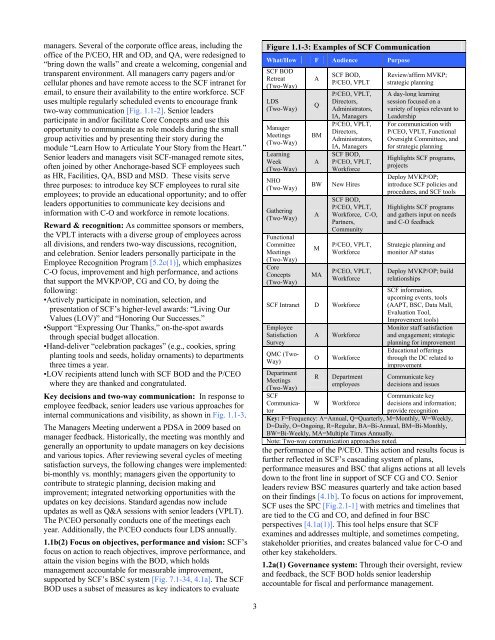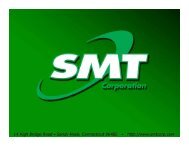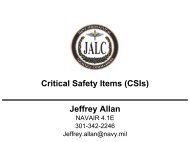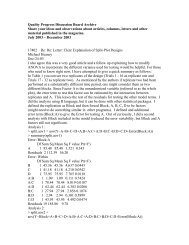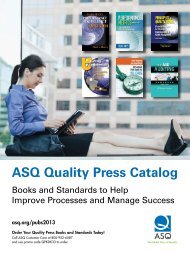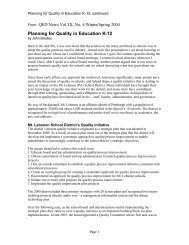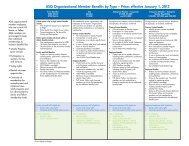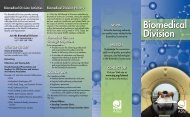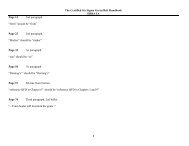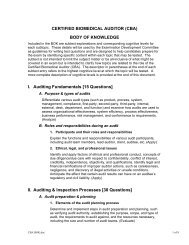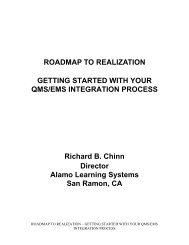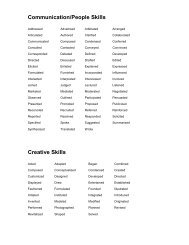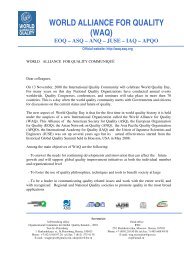Malcolm Baldrige National Quality Award - American Society for ...
Malcolm Baldrige National Quality Award - American Society for ...
Malcolm Baldrige National Quality Award - American Society for ...
You also want an ePaper? Increase the reach of your titles
YUMPU automatically turns print PDFs into web optimized ePapers that Google loves.
managers. Several of the corporate office areas, including the<br />
office of the P/CEO, HR and OD, and QA, were redesigned to<br />
“bring down the walls” and create a welcoming, congenial and<br />
transparent environment. All managers carry pagers and/or<br />
cellular phones and have remote access to the SCF intranet <strong>for</strong><br />
email, to ensure their availability to the entire work<strong>for</strong>ce. SCF<br />
uses multiple regularly scheduled events to encourage frank<br />
two-way communication [Fig. 1.1-2]. Senior leaders<br />
participate in and/or facilitate Core Concepts and use this<br />
opportunity to communicate as role models during the small<br />
group activities and by presenting their story during the<br />
module “Learn How to Articulate Your Story from the Heart.”<br />
Senior leaders and managers visit SCF-managed remote sites,<br />
often joined by other Anchorage-based SCF employees such<br />
as HR, Facilities, QA, BSD and MSD. These visits serve<br />
three purposes: to introduce key SCF employees to rural site<br />
employees; to provide an educational opportunity; and to offer<br />
leaders opportunities to communicate key decisions and<br />
in<strong>for</strong>mation with C-O and work<strong>for</strong>ce in remote locations.<br />
Reward & recognition: As committee sponsors or members,<br />
the VPLT interacts with a diverse group of employees across<br />
all divisions, and renders two-way discussions, recognition,<br />
and celebration. Senior leaders personally participate in the<br />
Employee Recognition Program [5.2c(1)], which emphasizes<br />
C-O focus, improvement and high per<strong>for</strong>mance, and actions<br />
that support the MVKP/OP, CG and CO, by doing the<br />
following:<br />
•Actively participate in nomination, selection, and<br />
presentation of SCF’s higher-level awards: “Living Our<br />
Values (LOV)” and “Honoring Our Successes.”<br />
•Support “Expressing Our Thanks,” on-the-spot awards<br />
through special budget allocation.<br />
•Hand-deliver “celebration packages” (e.g., cookies, spring<br />
planting tools and seeds, holiday ornaments) to departments<br />
three times a year.<br />
•LOV recipients attend lunch with SCF BOD and the P/CEO<br />
where they are thanked and congratulated.<br />
Key decisions and two-way communication: In response to<br />
employee feedback, senior leaders use various approaches <strong>for</strong><br />
internal communications and visibility, as shown in Fig. 1.1-3.<br />
The Managers Meeting underwent a PDSA in 2009 based on<br />
manager feedback. Historically, the meeting was monthly and<br />
generally an opportunity to update managers on key decisions<br />
and various topics. After reviewing several cycles of meeting<br />
satisfaction surveys, the following changes were implemented:<br />
bi-monthly vs. monthly; managers given the opportunity to<br />
contribute to strategic planning, decision making and<br />
improvement; integrated networking opportunities with the<br />
updates on key decisions. Standard agendas now include<br />
updates as well as Q&A sessions with senior leaders (VPLT).<br />
The P/CEO personally conducts one of the meetings each<br />
year. Additionally, the P/CEO conducts four LDS annually.<br />
1.1b(2) Focus on objectives, per<strong>for</strong>mance and vision: SCF’s<br />
focus on action to reach objectives, improve per<strong>for</strong>mance, and<br />
attain the vision begins with the BOD, which holds<br />
management accountable <strong>for</strong> measurable improvement,<br />
supported by SCF’s BSC system [Fig. 7.1-34, 4.1a]. The SCF<br />
BOD uses a subset of measures as key indicators to evaluate<br />
Figure 1.1-3: Examples of SCF Communication<br />
What/How F Audience Purpose<br />
SCF BOD<br />
Retreat<br />
(Two-Way)<br />
LDS<br />
(Two-Way)<br />
Manager<br />
Meetings<br />
(Two-Way)<br />
Learning<br />
Week<br />
(Two-Way)<br />
NHO<br />
(Two-Way)<br />
Gathering<br />
(Two-Way)<br />
Functional<br />
Committee<br />
Meetings<br />
(Two-Way)<br />
Core<br />
Concepts<br />
(Two-Way)<br />
A<br />
Q<br />
BM<br />
A<br />
BW<br />
A<br />
M<br />
MA<br />
SCF BOD,<br />
P/CEO, VPLT<br />
P/CEO, VPLT,<br />
Directors,<br />
Administrators,<br />
IA, Managers<br />
P/CEO, VPLT,<br />
Directors,<br />
Administrators,<br />
IA, Managers<br />
SCF BOD,<br />
P/CEO, VPLT,<br />
Work<strong>for</strong>ce<br />
New Hires<br />
SCF BOD,<br />
P/CEO, VPLT,<br />
Work<strong>for</strong>ce, C-O,<br />
Partners,<br />
Community<br />
P/CEO, VPLT,<br />
Work<strong>for</strong>ce<br />
P/CEO, VPLT,<br />
Work<strong>for</strong>ce<br />
SCF Intranet D Work<strong>for</strong>ce<br />
Employee<br />
Satisfaction<br />
Survey<br />
QMC (Two-<br />
Way)<br />
Department<br />
Meetings<br />
(Two-Way)<br />
SCF<br />
Communicator<br />
A<br />
O<br />
R<br />
W<br />
Work<strong>for</strong>ce<br />
Work<strong>for</strong>ce<br />
Department<br />
employees<br />
Work<strong>for</strong>ce<br />
Review/affirm MVKP;<br />
strategic planning<br />
A day-long learning<br />
session focused on a<br />
variety of topics relevant to<br />
Leadership<br />
For communication with<br />
P/CEO, VPLT, Functional<br />
Oversight Committees, and<br />
<strong>for</strong> strategic planning<br />
Highlights SCF programs,<br />
projects<br />
Deploy MVKP/OP;<br />
introduce SCF policies and<br />
procedures, and SCF tools<br />
Highlights SCF programs<br />
and gathers input on needs<br />
and C-O feedback<br />
Strategic planning and<br />
monitor AP status<br />
Deploy MVKP/OP; build<br />
relationships<br />
SCF in<strong>for</strong>mation,<br />
upcoming events, tools<br />
(AAPT, BSC, Data Mall,<br />
Evaluation Tool,<br />
Improvement tools)<br />
Monitor staff satisfaction<br />
and engagement; strategic<br />
planning <strong>for</strong> improvement<br />
Educational offerings<br />
through the DC related to<br />
improvement<br />
Communicate key<br />
decisions and issues<br />
Communicate key<br />
decisions and in<strong>for</strong>mation;<br />
provide recognition<br />
Key: F=Frequency: A=Annual, Q=Quarterly, M=Monthly, W=Weekly,<br />
D=Daily, O=Ongoing, R=Regular, BA=Bi-Annual, BM=Bi-Monthly,<br />
BW=Bi-Weekly, MA=Multiple Times Annually.<br />
Note: Two-way communication approaches noted.<br />
the per<strong>for</strong>mance of the P/CEO. This action and results focus is<br />
further reflected in SCF’s cascading system of plans,<br />
per<strong>for</strong>mance measures and BSC that aligns actions at all levels<br />
down to the front line in support of SCF CG and CO. Senior<br />
leaders review BSC measures quarterly and take action based<br />
on their findings [4.1b]. To focus on actions <strong>for</strong> improvement,<br />
SCF uses the SPC [Fig.2.1-1] with metrics and timelines that<br />
are tied to the CG and CO, and defined in four BSC<br />
perspectives [4.1a(1)]. This tool helps ensure that SCF<br />
examines and addresses multiple, and sometimes competing,<br />
stakeholder priorities, and creates balanced value <strong>for</strong> C-O and<br />
other key stakeholders.<br />
1.2a(1) Governance system: Through their oversight, review<br />
and feedback, the SCF BOD holds senior leadership<br />
accountable <strong>for</strong> fiscal and per<strong>for</strong>mance management.<br />
3


